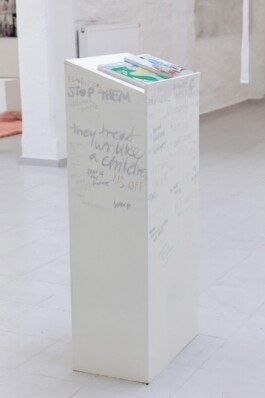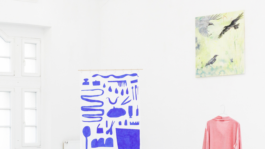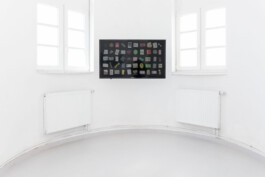Interview mit
Dorota Karolewska
Dorota Karolewska, Artist Talk
Tanja Heuchele: Can you describe yourself in 5 sentences?
Dorota Karolewska: Young artist living and working in Poznań, Poland. I graduated from the Department of Graphic Arts at the University of the Arts in Poznań (MA, 2019). I work with artistic textiles, embroidery, and intaglio printing techniques. Experimenting with form, technique, and matter is my main attraction in the creative process. Lately, finding pleasure in small and simple things in life.
TH: Your life without art would be…
DK: …unbearable.
TH: What material inspires you the most? And which materials are you working with the most at the moment?
DK: INSPIRATIONS: Fluffy textiles, soft and transparent materials, words. Delicate colors, shades of human skin in different conditions: blushed cheeks, bruises at different stages of development, etc.
WORKING: Small textile pieces, experiments with transparent glue and foils. I have recently been trying to do some oil painting (after a long break), but this time just for pleasure.
TH: Are there also materials that you would never use again?
DK: I never liked drawing with charcoal, so that – but that’s probably the only one. My apartment looks like an art supply store, so I am not used to closing myself off to any techniques or materials.
The Artist, Dorota Karolewska

Dorota Karolewska, Artist Talk
TH: What literature did you study for preparing your art piece(s)?
DK: This time, I needed to “study” the TVP1 News program on Polish public television. Almost every day for a few months. Which was very uncomfortable for me personally. The obvious propaganda makes me anxious every time I waste my time on it. I don’t like being treated like a fool.
TH: What is your work about? What is your intention with it? What should it evoke in the viewer’s emotion?
DK: In my work “Storytelling”, I wanted to focus on how Polish public media feeds viewers with political propaganda. The methods that they’ve been using lately are so obvious and banal that I honestly felt offended, treated like a kid – that is why I decided on a “childish” form for the work. While working, I was dogged by feelings of frustration, sadness, and irritation caused by the state of absurdity. I expect viewers of the work to experience their own true emotions, whatever they are (or not).
TH: When did the journey with Who’s afraid of_Rosa begin for you, and what keeps you involved?
DK: My journey with Who’s afraid of__Rosa started with the first show in 2019. The people involved in it, the conversation, the joint work in the organization and the high artistic value are what I appreciate most about it.
TH: How is the collective Who’s afraid of_Rosa organized? So far, I’ve only met female Rosa’s… can men also be part of it?
DK: I don’t see any reason why men couldn’t be involved.
TH: What does Rosa Luxemburg mean to you?
DK: This is still an open subject for me, so I would rather not give a rushed answer to this question yet.
TH: The subline of the exhibition is public space – private space – political space. What space do you (not) feel comfortable in? Where would you like to make a difference? What is your perception of space? Is it even the case that the above-mentioned spaces do not exist without each other?
DK: I see space as people and surroundings rather than actual physical locations or dimensions. That is why I feel uncomfortable around people with a tendency to judge others quickly, who see their own lifestyle as the one and only right way. Because of them, I value my privacy even more. More frequently, I experience a kind of dualism: in my private life things are getting better, and I am very happy about that, try to enjoy it and celebrate while I can, but on the other hand, what has been going lately in the Polish political and public arena devastates me. These bitter/sweet experiences can be confusing and make me feel guilty about simply smiling sometimes.
Dorota Karolewska, Exhibition View, 2021

Dorota Karolewska, Artist Talk
TH: How do you react to people who are not familiar with art, and how do you think they can be made to understand better?
DK: I’m actually used to them somehow, because I worked as a gallery assistant a while ago. My advice for them is to be open-minded to new experiences, try to observe things and think about matters from different angles sometimes, read more, visit galleries, museums more frequently, etc. Let’s see those experiences as a path full of possible adventures, and don’t expect that anyone “should” like or dislike something the same as others do.
TH: What do you enjoy about your life as an artist?
DK: That neediness about being comprehensive inside me. There is so much choice of materials, techniques, approaches, so I am sure that I will never be bored with it. I admire the way human nature changes and evolves. Art gives me a lot of opportunities to experiment with both form and content. Also, I find pleasure in meeting other artists, working with them, getting to know them and their art better. One funny reason is that I love to spend my earnings on art supplies, especially on paintbrushes – being an artist is a useful excuse then.
TH: What is great art for you?
DK: I’d rather name art that’s interesting or moving than GREAT – this term makes it more distant and haughty for viewers in my opinion. In the end, I see the relation between an art piece and its viewer as a very intimate and individual one.
TH: What about your next projects, exhibitions? Where can you be seen next?
DK: Don’t know yet, maybe something in Poznań, Poland. Lately, I’ve been focusing on a few smaller textile objects and etching/intaglio graphic experiments.
Dorota Karolewska, Exhibition View, 2021

Siehe auch
Mehr Interviews




